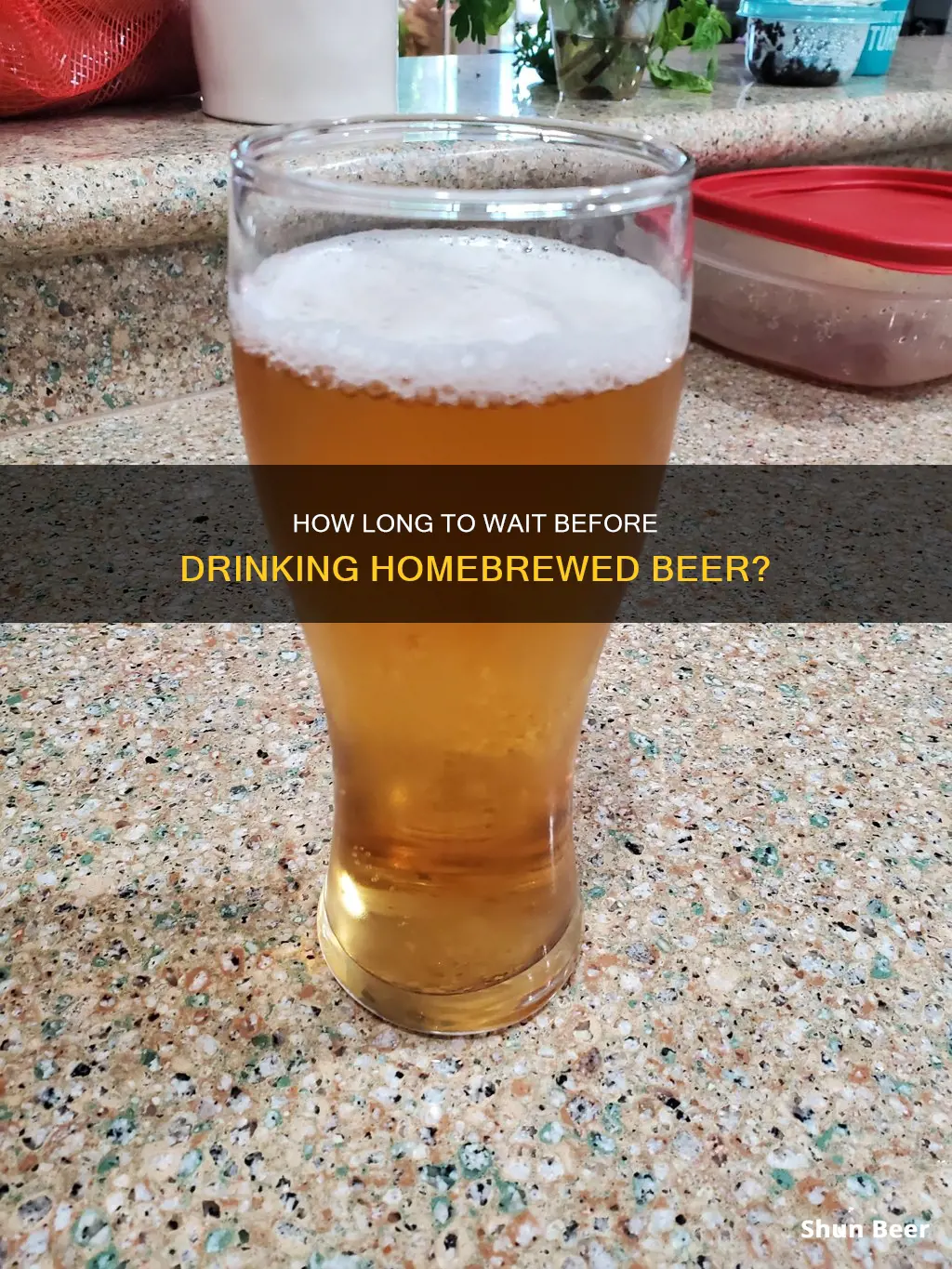
There are many variables that determine how long you should wait before drinking beer from a keg. The type of beer, the temperature at which it is stored, and the method of dispensing all play a role in how long a keg stays fresh. Generally, a keg of pasteurized beer will last about 90-120 days (3-4 months), while unpasteurized draft beer will last about 45-60 days (6-8 weeks) when stored at the proper temperature. The countdown starts from the day the keg is filled, not when it is tapped. If you're using a kegerator or draft system with CO2, the beer's freshness should not be affected as long as the keg is stored at the proper temperature and pressure. However, if you're using a picnic pump, party pump, or keg tap, the beer will only last about 12-24 hours due to the introduction of oxygen.
When it comes to the taste of the beer, it is recommended to let it condition for at least 2-3 weeks after gassing to improve the quality. The beer can be drinkable after a few days, but it will still be green and not ideal. Allowing it to sit for 6 weeks or more in the keg will substantially improve the quality. Additionally, the type of beer matters; lighter-colored beers need a couple of weeks of conditioning, dark beers need 4-6 weeks, and strong ales may need 3 months or more.
What You'll Learn

How long should I wait before drinking my kegged beer?
The time it takes for kegged beer to be ready to drink varies depending on the type of beer, the method of carbonation, and personal preference.
On average, it takes between 36 and 48 hours to gas a keg of beer with CO2. The beer then needs a couple of days to absorb the gas and become drinkable. However, it is recommended to wait at least two to three weeks after gassing for a nice-tasting beer. Leaving the beer in the keg for six weeks or more will substantially improve its quality.
If you force carbonate your beer at high pressure, it may be ready to drink in as little as 30 minutes. Alternatively, you can set your regulator to 30 psi for about three days, then purge and set it to serving pressure (usually around 12 psi) for one to two weeks. Some people also recommend ageing the beer at 'cellar' temperatures to allow the flavours to mature before carbonating at serving temperature.
It's important to note that the countdown for freshness starts from the day the keg is filled at the brewery, not when you tap it. The type of dispensing method you use will also affect how long your kegged beer stays fresh. Using a kegerator or draft system with CO2 should not impact the beer's freshness if the keg is stored at the proper temperature and pressure. However, using a picnic pump, party pump, or keg tap introduces oxygen into the keg, causing the beer to go flat and spoil within 12 to 24 hours.
Beer and Motrin: Safe Mix or Health Risk?
You may want to see also

How does kegging affect the taste of my beer?
Kegging is a great way to store your beer, but it can affect its taste. The taste of your beer will depend on how long you wait after kegging before drinking it, and the method you use to dispense it.
The beer will be drinkable a few days after kegging, but it will be extremely "green" and not ideal. The minimum time to wait for a nice beer is two to three weeks, and six weeks or more will substantially improve the quality. The longer you wait, the better it will taste.
If you use a kegerator or draft system with CO2, this should not impact the freshness of your beer, as long as the keg is stored at the proper temperature and pressure. However, if you use a picnic pump, party pump, or keg tap, this will introduce oxygen into the keg, which will cause the beer to go flat and spoil quickly. In this case, the tapped keg will only last about 12-24 hours, depending on the type of beer and how much oxygen was pumped into it.
The recommended temperature for storing draft beer is 38 degrees Fahrenheit. Warm beer will pour foamy, and keeping beer at room temperature will cause bacteria to form. Beer will freeze at around 28 degrees Fahrenheit, depending on its alcohol content.
In addition to the time and method, other factors such as the recipe, type of ale, and fermentation process will also affect the taste of your kegged beer. Lighter-coloured beers need a couple of weeks of conditioning, while dark beers need four to six weeks, and strong ales like imperial stouts might need three months or more.
Beer and Ulcers: Is it Safe to Drink?
You may want to see also

What is the best method for storing kegged beer?
Storing kegged beer requires a bit of patience and a few considerations to ensure the beer stays fresh and tasty. Here is a guide on the best methods for storing kegged beer:
Temperature Control
Maintain consistent temperatures when storing kegged beer. While there are differing opinions on whether to store beer at cold or room temperature, the key is to avoid extreme temperature changes. Keep the beer at a steady temperature, whether in a refrigerator, basement, or garage. Aim for temperatures around 38°F for ales, slightly lower for lagers, but avoid going too high, as it can affect the carbonation and flavour of the beer.
Light Exposure
Keep the kegged beer away from direct light. Use opaque containers or store in dark places like basements or garages, ensuring minimal light exposure to prevent damage to the beer's quality.
Pressure Maintenance
Proper pressure is crucial for maintaining the desired carbonation levels in kegged beer. Generally, a pressure range of 10-12 psi is ideal for American ales and lagers, but this may vary depending on the brand and style of beer. Consult the distributor or brewery for specific recommendations. Avoid too high or too low pressure, as it can lead to excessive foaming or flat beer.
Settling Time
Allow the kegged beer to settle before tapping. Limit shaking or rolling the keg, and let it rest for at least an hour or two before serving. This will help reduce foaming and ensure a smoother pour. The settling time also depends on the time taken to reach the proper temperatures, so adjust accordingly.
Aging Considerations
While fresh beer is usually best, some beers benefit from ageing. Higher ABV beers tend to age well, and the type of beer determines the length of storage. Hoppier beers like IPAs may not retain their key characteristics over time, while maltier beers like Imperial Stouts and Porters can improve with age if proper ageing procedures are followed.
Organised Storage
If you have multiple kegs, organise them to ensure easy access without jostling other kegs. Create a system like "First In, First Out" (FIFO) to rotate your stock and ensure you're drinking the oldest kegs first. Label your kegs to avoid confusion, especially if you have a variety of beer styles.
Beer and Eliquis: Safe Mix?
You may want to see also

What is the best temperature for storing kegged beer?
The best temperature for storing kegged beer depends on the type of beer and the desired taste. Most of the time, the beer inside your keg has not been pasteurized, so it's important to keep it cold. When the temperature is too high, foam dominates the beverage because the higher temperature liberates carbon dioxide too quickly. This will cause your beer to foam more than it should, leading to a loss in flavor.
Conversely, draft beer that is too cold retains carbonation, causing the beer to taste flat because the true flavor cannot escape. The optimal temperature to store and serve your draft beer is right at 38°F, especially for ales. You can go slightly lower without sacrificing the quality of the beer, but it’s not recommended to go above that temperature.
Any reputable kegerator system should be able to maintain the proper temperatures to avoid these problems. It's also important to note that beer ages faster at temperatures closer to fermentation temperatures, so the cooler you keep the beer, the longer it will stay in the condition at which you originally put it in cold storage.
Canoeing and Beer: What's the Legal Verdict?
You may want to see also

Can I bottle beer after kegging?
Yes, you can bottle beer after kegging. In fact, bottling beer is a good way to store, mail, or share a small quantity of your beer. It is also the only way to enter a brewing competition. However, it is not a required process for anyone who wants to enjoy their own beer at home and does come with some drawbacks.
There are several methods for bottling beer after kegging, ranging from inexpensive and easy to more costly and time-consuming. Here is a step-by-step guide to one of the easiest methods:
Method 1: Using a Picnic Dispenser
Step 1: Gather the necessary equipment, including a picnic keg dispenser tap and food-grade vinyl tubing.
Step 2: Cut the tubing at a 45-degree angle to reduce foaming during the pour.
Step 3: Attach one end of the tubing to the tap and insert the other end into the bottle, ensuring it reaches the bottom.
Step 4: Open the tap and start filling the bottles.
Step 5: Make sure to cap each bottle immediately to prevent the escape of CO2.
It is important to note that bottling beer directly from a keg can result in excessive foaming and decarbonization. To minimize foaming, it is recommended to chill the bottles before filling and to keep the keg and bottles cold during the process. Additionally, reducing the pressure and dispensing slowly can help reduce foaming.
While bottled beer is convenient for sharing and transporting, it is important to allow the beer sufficient time to age and carbonate properly before drinking. Beer can be drinkable as early as a few days after kegging, but it is recommended to wait for at least 2-3 weeks to ensure better quality.
Beer and Breastfeeding: What's Safe?
You may want to see also
Frequently asked questions
There is no one hard and fast rule for how long a keg of draft beer will stay fresh. The shelf life for a keg of pasteurized beer is about 90-120 days (or 3-4 months), and unpasteurized draft beer will last about 45-60 days (or 6-8 weeks) when stored at the proper temperature.
Using a kegerator or draft system that dispenses draft beer using CO2 should not impact your beer’s freshness as long as the keg is stored at the proper temperature and pressure. Using a picnic pump, on the other hand, introduces oxygen into your keg, which greatly speeds up the process of beer going bad. A tapped keg will last about 12-24 hours, depending on the type of beer and how much oxygen was pumped into it.
The recommended temperature for storing draft beer is 38 degrees Fahrenheit. Beer will freeze at around 28 degrees, depending on its alcohol content. Bacteria can form in beer if its temperature rises above 50 degrees.







